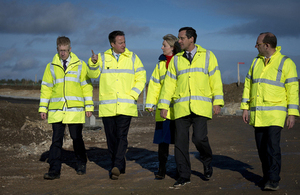PM and Chancellor welcome £36 billion infrastructure projects
£36 billion planned investment into infrastructure for 2014 to 2015 could support over 150,000 construction jobs.

The Prime Minister and the Chancellor will visit a transport infrastructure project today (22 April 2014) to see how the government is helping hardworking people and backing businesses with investment in better infrastructure.
Visit the We Are Building Britain Tumblr site to see some of the projects that are building Britain, and join in the conversation online using the hashtag #BuildingBritain.
More than 200 projects due to start construction in 2014 to 2015
They will highlight that, as part of this government’s long-term economic plan to help Britain succeed, more than 200 projects in rail, road, local transport, flood defences, broadband, airport infrastructure and waste management are due to start construction in 2014 to 2015. These include the Mersey Gateway Bridge, Sheffield Lower Don Valley and Exeter flood defence schemes and the A1 Barton to Leeming motorway upgrade, which will reduce journey times by 20 per cent.
Another 200 infrastructure projects are also due to be completed this year, including major roads such as the M6 J10A-13, Nottingham tram extension, Heathrow Terminal 2 upgrade and Gwynt y Môr offshore wind farm, which is currently the largest in construction anywhere in Europe.
The projects due to start construction this year are part of £36 billion of planned investment - £5 billion public investment, £21 billion private investment and £10 billion in joint public and private investment - in infrastructure across the country that could support over 150,000 jobs in construction and many thousands more in other sectors following completion. This includes the start of a £38 billion programme of rail spending over the next 5 years.
In addition, there is expected to be further investment of up to £15 billion in oil and gas this year.
First class infrastructure
Prime Minister David Cameron said:
Ensuring Britain has first class infrastructure is a crucial part of our long term economic plan: supporting business, creating jobs and providing a better future for hardworking people.
As a crucial part of our long-term economic plan, this government is backing business with better infrastructure so that more jobs and opportunities are created for hardworking people, meaning more financial security and peace of mind for families.
Chancellor of the Exchequer George Osborne said:
As part of our long term economic plan we are investing in infrastructure around the country to create a more balanced, resilient economy.
Because of the tough decisions we have taken in day to day spending, we can prioritise public investment where it is most needed and create the right conditions for private investment in infrastructure where it brings value for the taxpayer.
So this year over 200 new projects worth an estimated £36 billion are due to start, creating thousands of jobs, securing future growth and delivering the world class infrastructure Britain deserves.
Throughout this parliament, the government has consistently made tough decisions on day to day spending that have enabled the prioritisation of vital capital investment. In June 2013 the government built on this approach by setting out a further commitment to invest in over £100 billion of capital in specific projects in the next parliament, including providing long-term funding settlements in key infrastructure sectors.
The government has also taken radical action to unlock and stimulate private sector investment, which is expected to make up the majority of UK infrastructure investment between now and the end of the decade. This has included setting out a plan to generate a wave of new investment in our energy infrastructure through the biggest change to the electricity market since privatisation, and the provision of up to £40 billion of support for critical infrastructure projects through the UK Guarantees Scheme.
Read the National Infrastructure Plan, which sets out the government’s plan for the next decade and beyond.